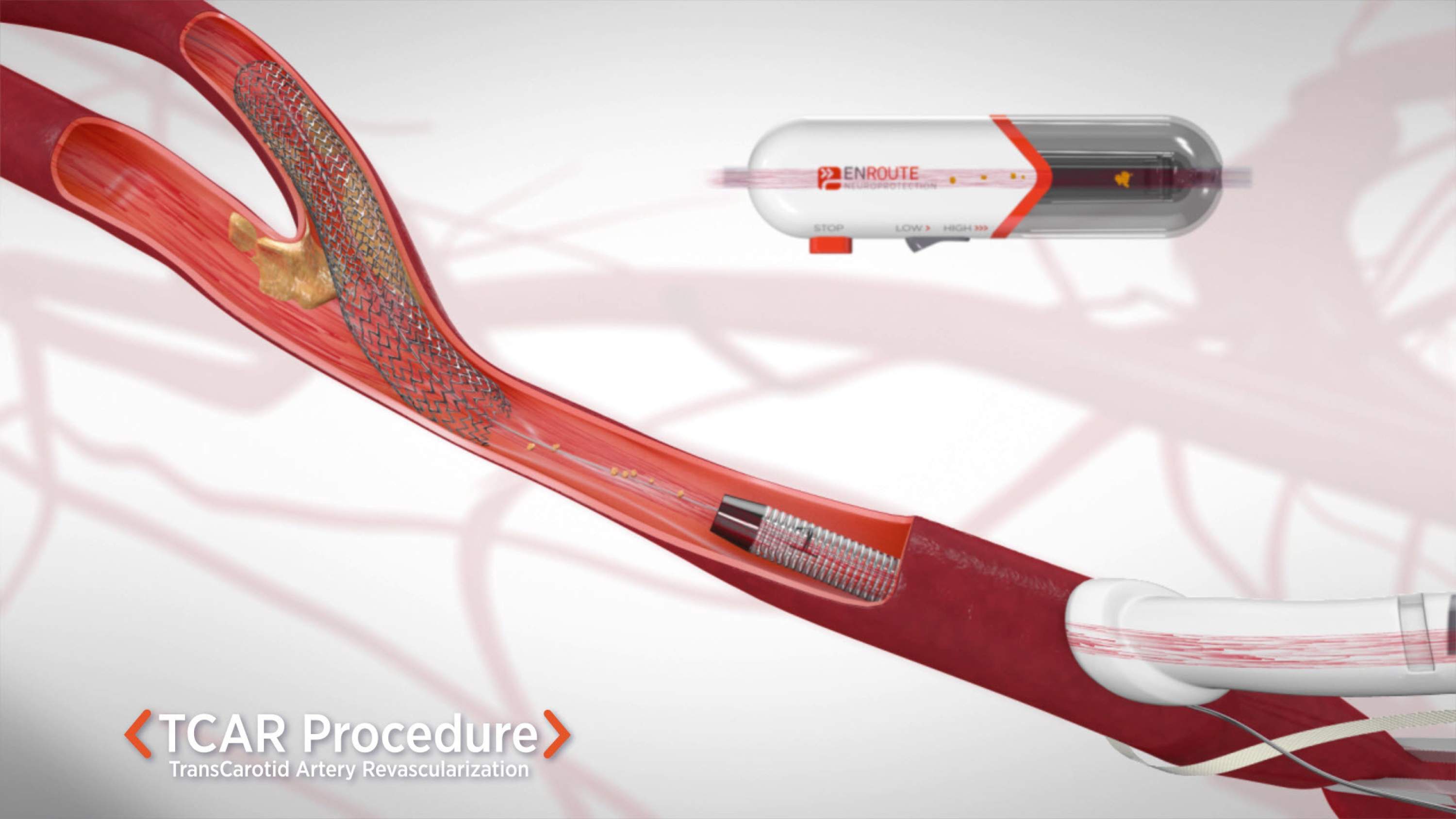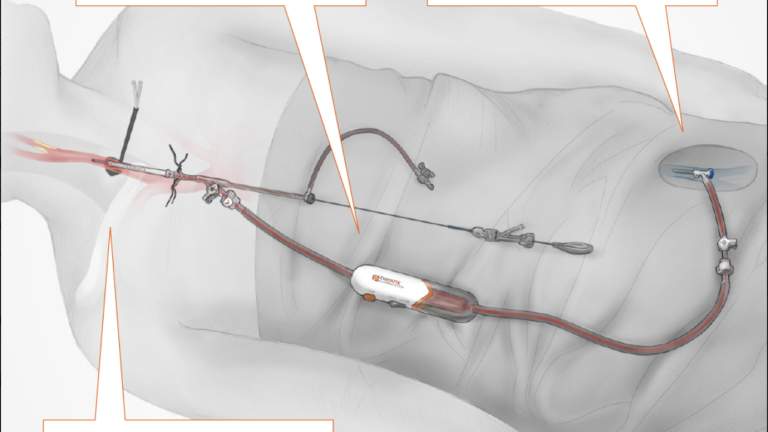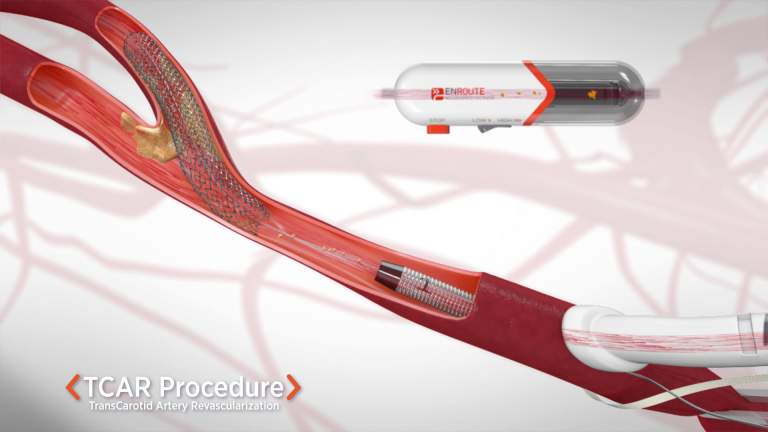Carotid Artery Stenting (TCAR)
TCAR: A Minimally Invasive Option to Treat Carotid Disease

Here at BEVSA, we are excited to have surgeons specially trained and experienced in performing the TCAR procedure for our patients with severe carotid disease. The TCAR procedure is a minimally invasive option tailored for our patients who may be at high risk for a traditional open surgery.
Who is Eligible for TCAR?
The carotid arteries are responsible for supplying blood and oxygen to the brain. As plaque develops in the carotid artery, it can become a significant enough blockage to prevent blood flow to the brain and potentially cause a stroke. In addition, the plaque in the carotid artery can cause a stroke by breaking off and traveling to smaller blood vessels in the brain.
For patients without any signs or symptoms of stroke, your vascular surgeon will assess your carotid artery images to determine if the plaque in the carotid artery is significant enough to put you at high risk for stroke. Sometimes, patients may have had a recent stroke or Mini-stroke (TIA) and are found to have high amounts of plaque in the carotid artery. Both of these scenarios are referred to as severe carotid artery disease and usually warrant a carotid procedure to remove plaque and lessen the patient's risk of stroke.
Once your surgeon has determined that you are a candidate for a carotid artery procedure. They will assess your imaging studies, surgical risks, age and medication list to determine if you are a better candidate for a minimally invasive TCAR procedure versus a traditional open surgery. TCAR is well suited for patients who are at higher risk of surgical complications due to age, medical comorbidities, or anatomical issues.
Procedure Details
The TCAR procedure takes about 2-3 hours at Gates Vascular Institute and most patients are put under general anesthesia.
The procedure begins with a small incision above the collarbone. A catheter (long tube) is then guided into the carotid artery. A stent, which is a metal tube, is placed over the diseased area of the carotid artery to widen the artery and improve circulation.
To prevent any plaque from breaking off of the carotid artery and travelling to the brain during the procedure, TCAR utilizes a “flow reversal” system. The surgeon creates a temporary circuit outside of the body that reverses blood in the carotid artery and prevents it from travelling to the brain. The blood is then passed through a filter that collects any plaque debris and safely returns blood to a vein in the leg. During this portion of the procedure, the stent is placed over the diseased portion of the carotid artery.
Patients, at a minimum, will spend 1 night in the hospital, and most are discharged the following day. Our practice at BEVSA is one of the leaders in TCAR procedures in the WNY region and our surgeons have performed over 100 successful surgeries. For more information about TCAR, and to hear one of our surgeons explain the procedure, click on the video below.
Patient Stories
Here at BEVSA, we pride ourselves on engaging with our patient’s stories and feedback. The following stories help highlight how our superior vascular care and compassion translates from our office to improving the everyday lives of our patients. We hope these stories provide comfort to our patients and their families and illustrate how our team at BEVSA goes above and beyond for our patients everyday.
Roger's TCAR Story
After Roger’s sister underwent a carotid surgery with BEVSA, he spoke to his primary care doctor about his concerning family history of carotid disease. Shortly after, testing results indicated that Roger had a very tight narrowing of his carotid artery which put him at high risk of developing a stroke. Roger was then referred to Dr. Noor and our team at BEVSA for an urgent, minimally invasive, carotid stenting procedure called TCAR. Watch the video below to learn about Roger’s journey with carotid disease, and how he was able to get back to the hobbies that he enjoyed.
Frequently Asked Questions
How safe is TCAR?
Over 100,000 TCAR procedures have been performed worldwide through clinical trial and commercial use. TCAR has been studied extensively, and the clinical data has been excellent. In addition, our surgeons at BEVSA are all TCAR Certified through Silk Road Medical’s Certification Program. Our practice is one of the leaders in TCAR procedures in the WNY region and our surgeons have performed over 100 successful surgeries.
How is TCAR better for patients?
TCAR has a very low procedural stroke rate. It is also less invasive than open surgery, so there’s less chance for surgical complications like heart attacks, infection and nerve injury. TCAR patients also recover quickly and almost always go home the next day with less pain and smaller scars.
Is it ever a problem that the blood is being diverted away from the brain during the procedure?
It’s rarely a problem because the brain has multiple arteries that supply it with blood. In addition, the critical part of the procedure, when the blood flow is reversed, only lasts about 10 minutes. The TCAR procedure also utilizes neuromonitoring to assess the patient’s brain activity throughout the procedure to ensure the brain is receiving adequate circulation.
Why is it important to adhere to the medication guideline both before and after the procedure?
The stent being placed in the carotid artery takes approximately one month to incorporate itself fully into the carotid vessel wall. Until this happens, the stents are prone to platelets, which are found naturally in the blood stream, sticking to the stent and potentially causing stent thrombosis and stroke. However, taking your prescribed medications for TCAR both before and after the procedure serves as a protective measure in preventing platelet aggregation and stroke.
Why is it important to follow up with my physician multiple times after the procedure?
After your TCAR procedure, it is important to continue seeing your vascular surgeon so they can examine your incision site and ultrasound scan your carotid artery to ensure the stent is working properly. In addition, many patients that have had a carotid procedure also have disease in the other carotid artery which needs continuous monitoring and potential intervention to ensure the patient is at a decreased risk for stroke.
Will I feel any different after the procedure?
For some patients who have had a past history of stroke or TIA, the TCAR procedure can help alleviate symptoms. However, for the majority of patients, this procedure is a preventative measure meant to reduce the risk of the patient developing a stroke in the future. Therefore, most patients report being back to their usual activity within a few days after the procedure.
What are some side effects of being on a Blood thinner?
Most patients do not report any side effects while being on a blood thinner. However, some of the most common side effects that may occur are easy bleeding/bruising, stomach discomfort/pain, and diarrhea. To lower the chance of getting cut, bruised, or injured, use caution with sharp objects like razors and nail cutters, and avoid activities such as contact sports. If you are having any issues with your medications, be sure to contact your prescribing physician.
Why do I have to go on a statin prior to and after the procedure even if my cholesterol is well managed?
Not only do statins help lower cholesterol, but they are also an effective medication in stabilizing carotid plaque. Stabilizing plaque reduces the risk of plaque breaking off the carotid artery and potentially causing a stroke prior to or after your TCAR procedure. Statin use is associated with lower rates of stroke, mortality, and in-stent restenosis for patients after carotid stenting.

